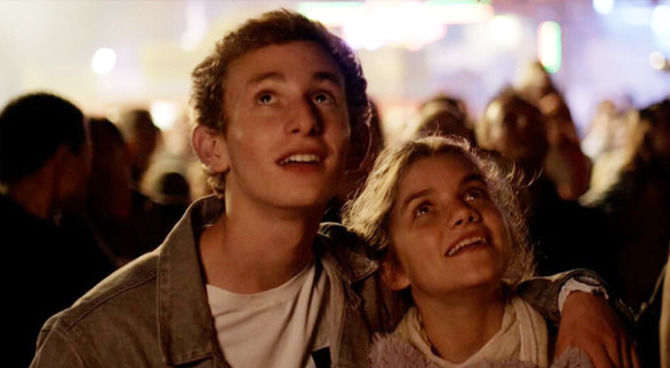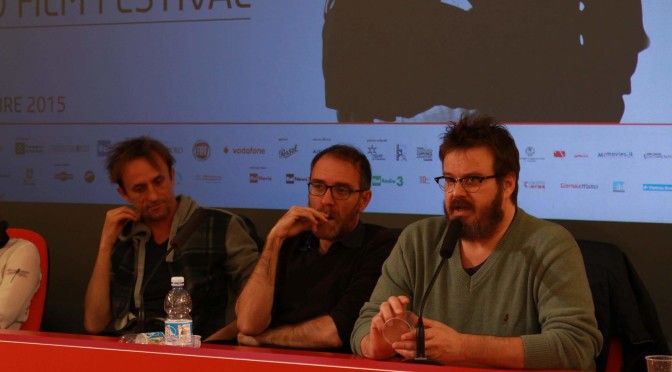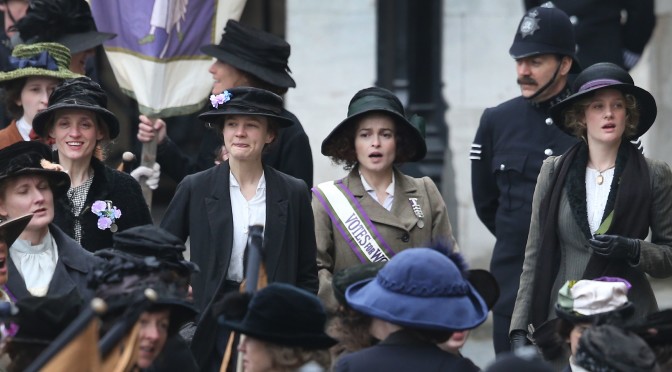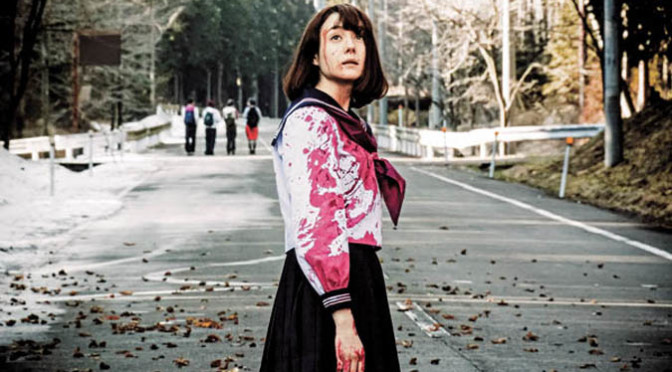Ieri sera si è conclusa la 33° edizione del Torino Film Festival; il premio come miglior film è andato all’opera del regista belga esordiente Guillaume Senez, Keeper. Sull’ondata di programmi di successo quali 16 anni e incinta, trasmesso su MTV, il film racconta l’esperienza di una gravidanza in giovane età.
Archivi tag: Torino 33
ARTRUM, un dialogo tra arte e cinema
La sezione ONDE – ARTRUM, nasce all’interno della rassegna della 33º edizione del TFF curata dalla Fondazione Sandretto Re Rebaudengo, centro per l’arte contemporanea sempre attento alla contaminazione fra le diverse realtà artistiche, in collaborazione con Anna Lenna Films, produttrice di film d’arte da più di quindici anni. La rassegna comprende sei film che segnano un percorso sul laceramento dello spazio e del corpo, e attraverso un circuito di carattere ritmico, impongono allo spettatore un crescendum di forze visive e sonore.
“John From” di João Nicolau
Gli anni dell’adolescenza sono i più belli e contemporaneamente i più brutti della nostra vita. Questa è una tipica frase con la quale non si sa mai se essere d’accordo o no; di certo è vero che gli anni dell’adolescenza sono quelli in cui i nostri sogni cominciano a prendere forma, a deragliare dai binari infantili verso la dura realtà. E’ un processo quasi obbligato nel percorso dall’adolescenza all’età adulta. Nel film di João Nicolau accade esattamente l’opposto.
John From by João Nicolau
Article by: Barbara Vacchetti
Translation by: Martina Taricco
Teens years are the most beautiful and the worst moments of everyone’s life at the same time: this is a classic cliché with which you never know if to agree or not. Certainly, we usually think that adolescence years are those in which our dreams start to take a more real shape and run off the rails of childhood towards the tough reality, an almost inevitable course from adolescence to adulthood. In the movie of João Nicolau we see the exact opposite of what written above.
The protagonist is Rita: she is fifteen years old and lives with her parents in a huge and odd apartment building where blue prevails. Blue are the lift doors, the mailboxes, the balconies railings. Blue is the perfect colour for the summer during which the movie is set. Perennially on the edge of boredom that is going to submerge her, Rita spends summer walking through the city, playing the pipe organ in a recreation centre and going to parties with her friend, who lives in the same building with which she exchanges some messages written on slips of paper that they hide in the lift.
To break up the monotony of this hot summer, a new neighbour comes: a man who is about thirty-five with his little daughter who has to provide for. His name almost eludes the audience attention because very soon, this absent-minded photographer calls the attention of Rita. Nonetheless, the girl does not see him as he truly is but as the character of the title, John From.
Aided by the fact that the photographer is exhibiting the pictures that he shot in Melanesia, Rita starts to imagine him as the god John From that, according to Melanesian legends, is described as an American soldier “fallen from the sky”. Rita connects this legend to her new neighbour, fallen from the sky as well, like a blessing or a potion against the boredom. Therefore, the attempts of Rita to approach him begin but they all end in inconclusive meetings.
In the midst of her daydreaming, Rita starts to mix up what really happens with what she would like to happen; the boundaries between reality and imagination becomes more and more weak until they merge together. It is therefore difficoult to distinguish the reality from the dream, so that when we are in love, an ordinary wave becomes a sign of fate. Rita plays a game: she questions her iPod, close her eyes, browse the songs then she stops at random and the title of the song should tell her the answer to her question.
Nicolau shows us this adolescent world in a disenchanted and realistic way, dressed up with a touch of irony that could make the movie irresistible. A world in which the parents are distant but caring all the same, teenagers are mature thanks to their experiences and disappointments and an ordinary crush could turns into an endless dream of a wedding and beach games.
In fabbrica (At the Factory) by Francesca Comencini
Article by: Lara Vallino
Translation by: Roberto Gelli
Contemporary images of FIAT plants during the night covered by the machinery’s noise. Break. Second worldwide postwar period: Sicilian children are interviewed about the matter “Where are you dads?” “They are in Germany”.
This is the beginning of Francesca Comencini’s documentary entitled In fabbrica: Cipputi Award winner in 2007 as the best film about work. This year Comencini has received the lifetime achievement award in TFF.
During the Fifties Italy relies on industry, in order to improve working life, which can guarantee a better lifestyle. In a short dialogue between a journalist and a worker we hear “Is it easy to find a job?”, “Yes, there is a lot”, which causes some astonishment among the modern spectators, who got used to the term precariousness. But those years represent the highest point for the local economy, the so-called economic boom: from all the areas of the peninsula people move towards the big northern industries, so as to find a job. “Would you come back home to Naples?”, “No, not even if they covered me with gold”, this is the reply given by a girl defending her new status of worker. The interviewed show themselves to be always satisfied, in a time when job is a source of money and sustenance. What is more, it is something, which people can be proud of. On the other hand, this period also witnesses a strange combination between guaranteed jobs and black market labour, sometimes related to child labour.
Those years give progressively birth to a class consciousness, which results in the first FIAT workers uprising in 1962. If it is true that they get better work conditions, more problems seem to arise like that concerning the housing of people coming from the south. As a female worker stated in 1968: “those who always work by using their arms, lose mental agility, memory and thinking ability”. This situation leads towards new strikes aimed at removing production lines: workers now want to take part at the production activity, not only by tightening bolts, but by putting something of their own into the final products.
With the 80’s the concepts of profit and progress come onto the scene and automation systems are adopted in the firms. Workers form picket lines surrounding FIAT plants 35 days long, the firm replies imposing unemployment insurance. On 14th August, 1980 workers not involved in the measure, together with common citizens, demonstrate in the streets of Turin. It is the so-called “March of the forty thousand”; an invisible crowd of people opposing workers strike and demonstration. The unprecedented event is a sign of a rising individualism and negation of class consciousness. From that time on, there were in fact no strikes anymore.
Nowadays factories are still there but their workers have become a sort of invisible entity: none of them thinks about protesting or striking. There is an emptiness in terms of unity, that same unity which would let the situation change. Above all, none seems to believe in change anymore. A sense of resignation and indifference has spread among workers causing the maintaining of the status quo, which was conquered through efforts during those years, when consciousness of factory workers in Italy was born.
“La felicità è un sistema complesso” di Gianni Zanasi – Conferenza stampa
Mastandrea show
Domenica mattina, alla Conferenza stampa del Torino Film Festival era presente quasi l’intero cast de La felicità è un sistema complesso, tanto che non sono bastati i posti a sedere dietro il tavolo. A parte il regista Gianni Zanasi e la montatrice e produttrice Rita Rognoni, infatti, abbiamo assistito agli interventi di Valerio Mastandrea, Giuseppe Battiston, Hadas Yaron, Teco Celio, Filippo De Carli e Camilla Martini.
Continua la lettura di “La felicità è un sistema complesso” di Gianni Zanasi – Conferenza stampa
“Borsalino City” di Enrica Viola
Borsalino City, della sempre molto fornita sezione Festa Mobile, è un documentario diretto da Enrica Viola e prodotto dalla UNA Film. Il film ripercorre la storia della ditta Borsalino; fondata ad Alessandria nel 1857 da Giuseppe Borsalino, ottenne fama internazionale con il Grand Prix del 1900 tenutosi a Parigi. Pochi mesi dopo, Giuseppe – che aveva studiato l’arte del cappellaio in giro per il mondo – morì, lasciando la Borsalino in eredità al figlio Teresio Borsalino. È in questi anni che si creò una faida all’interno della famiglia, con la scissione del cugino di Teresio, Giovanni Battista Borsalino, il quale fondò una nuova ditta chiamata Borsalino Fu Lazzaro; da questa faida nacque l’idea che forse, il vero inventore del cappello Borsalino, non era stato Giuseppe, ma suo fratello Lazzaro (il padre di Giovanni Battista). Teresio lasciò la ditta di famiglia in mano al nipote Teresio Usuelli, durante il cui mandato si festeggiò il centenario della nascita della ditta Borsalino, nel 1957; sono i loro discendenti, tra cui Vittorio Vaccarino, che raccontano le faide, le imprese e i ricordi della loro impresa di famiglia.
“La felicità è un sistema complesso” di Gianni Zanasi
Enrico Giusti fa un lavoro utile: avvicina incompetenti dirigenti d’azienda, li ascolta, ne diventa amico, e infine li convince a cedergli l’azienda che non sono in grado di dirigere. La sua bravura consiste nel far credere che sia stata una loro idea. È il migliore nel suo campo, ma un senso di colpa lo perseguita: saranno davvero tutti cavallette?
Continua la lettura di “La felicità è un sistema complesso” di Gianni Zanasi
“Rak ti khon kaen” (“Cemetery of Splendour”) di Apichatpong Weerasethakul
– Mi hanno detto che ha un’amante. Riesci a vedere dove la tiene nascosta?
– Riesco a vedere solo la sua vita passata.
– Focalizzati sul presente, per favore. Voglio saperlo.
Una moglie tradita siede al capezzale del marito in coma in compagnia di una giovane sensitiva la quale, come lo zio Boonmee, si ricorda le vite precedenti. Ci troviamo nel piccolo ospedale di un villaggio dell’entroterra thailandese. Lo stesso villaggio in cui è cresciuto il regista Apichatpong Weerasethakul (la madre era medico in una struttura molto simile) e in cui ritorna dopo aver vissuto e lavorato negli Stati Uniti.
Continua la lettura di “Rak ti khon kaen” (“Cemetery of Splendour”) di Apichatpong Weerasethakul
The Press conference: Suffragette Opens 33 TFF Press Conference
Article by: Danila Prestifilippo Translation by: Roberto Gelli
Not only was Suffragette shown yesterday evening to inaugurate 33th TFF, but also the film was the protagonist of the first press conference, which took place this morning. Film director Sarah Gavron, screenwriter Abi Morgan and one of its producers Faye Ward answered journalists’ questions and explained the film goals and the choices they made, in order to create the short film.
Muad (Carey Mulligan), a female worker, is the protagonist. She is a fictional character and fights together with other women, who represent really existed historical feminists like Emmeline Pankhurst (Merylin Streep). As director Gavron pointed out, the aim of this semihistorical approach was to make a connection between the women, who were given the mocking name Suffragettes and started their battle for their right to vote hundred years ago and modern women, who are still struggling with salary discrepancy, sexual violence and for their right to children protection and tutoring.
Suffragettes social movement has fought for fifty years but, if it is true that the first forty years had been a pacific struggle, in the following sixteen months the fight became more violent and cruel and almost none knows about it. The absence of films that tell us about the violence these courageous women had to endure, played a great role in persuading Faya Ward and Alison Owen to produce the film. Faya Ward stated: “We wanted the public to be aware of the importance of the sacrifices and the success related to Suffragettes fight. We also wanted to underline how their results are effective in nowadays society. We have tried to give modern spectators some contact points, in order for women not only to be politically active, but also to encourage them to be and become what they really feel they are or they could be. Our attempt was to give voice to those, who were not yet given their chance on the big screen.”
Abi Morgan, who had already been the screenwriter of movies such as The Iron Lady, emphasized that the challenge was to choose a really meaningful example of woman’s life and be able to put it in a precise historical context. She said: “On the one hand the character of Muad underlines the role of lots of passive supporters who became activists, on the other hand it investigates the reasons which persuaded women like her to put their jobs, their families and their homes at risk, in the name of a civil right”. The film focuses on the political matter and puts in the foreground these courageous protagonists, so the decision to not examine in depth personal stories was due to the fact that there are not enough literary or movie material at disposal, to which one can refer to. With reference to that, Morgan added that it was much more important to end the film with information about Saudi Arabia and its 2015 law concerning women right to vote only if accompanied by men, rather than to think at some sort of dramatization of Maud in the Hollywood style.
Sarah Gavron gave some further meaningful figures: “Still today, 66 million of women worldwide have no right to vote, 2/3 are illiterate and only 22% hold public offices. It says that the face of poverty is female and unfortunately these figures confirm it”.
The film’s aim is not only political and historical, it concerns the social matter too by denouncing and preventing the high young people abstaining rate, above all among women. Director Gavron told about the reaction of most of the female audience attending Suffragette’s introduction meetings. As she had hoped, after seeing the film, they expressed their wish to vote again because it made them aware of the sacrifices made by British feminist movement. She also reported that the troupe film (almost completely composed by women) wanted to give a clear signal during the film shooting, so they symbolically demonstrated against government by obtaining the permission to film in the House of Parliament in London, that same institutional place, which had declared against women right to vote.
Asked about a possible way to increase female presence in all sectors, starting from institutional offices, Abi Morgan answered: “We have to introduce the concept of positive discrimination and keep insisting about the importance women have within a context implying equality of the sexes. Geena Daves said “See in order to Be”: we need to have a radical attitude, to leverage the mass media but, in order to be successful, women complicity is essential”.
Faye Ward ended the press conference by making a consideration about the fact that Suffragette is a film of women who fight for their right to vote but “today the concept of fight may imply different ways. Each one of us can be what he wants to be, and this is true for both genders and all races. It is enough that we find our own voice and utter our words in every place, in political institutions or other kind of institutions.
“February” di Osgood Perkins
Si dimostra una rivelazione Osgood Robert “Oz” Perkins, figlio dell’attore Antony Perkins, con la sua prima opera da regista: February, un horror thriller. In precedenza lo avevamo visto come attore in Psycho II e più recentemente nel ruolo di sceneggiatore in The Girl in the Photografs.
February è sicuramente un film che crea atmosfera. In sala si percepiva il gelo pungente delle strade innevate, così bianche che trasmettevano un senso di serenità, ma con la sensazione che non sarebbe durata a lungo. Infatti ben presto queste stesse strade sarebbero state deturpate da strisce rosse di sangue.
February by Osgood Perkins
Article by: Valentina Di Noi
Translation by: Chiara Toscan
Osgood Robert “Oz” Perkins, son of the actor Antony Perkins, proved to be a wonder with his first work as a director, the horror thriller February. We have already seen him acting in Psycho II and more recently screenwriting The Girl in the Photographs.
February is undoubtedly a film that creates an atmosphere. The theater was immersed in the sharp frost of the snowy streets that were so white they gave a sense of purity. However, such sensation was not meant to last, as soon those streets were going to be spoiled by trails of blood.
The film is set in Kempville, Ontario Canada. It’s February and the students of the all girls boarding school “Kempville” are getting ready to leave for their hometown for the winter break. Kate (Kiernan Shipka) and Rose (Lucy Boynton) are stuck at school because their parents have mysteriously failed to retrieve them. Rose finds herself forced to babysit Kate even if they are not friends but rather share resentment. At the same time, Joan (Emma Roberts), escaped from a mental health facility, is heading towards the school, while Kate starts to have a strange attitude.
In this feature film lingers not only tension but also teenage crisis and inner torments, especially through the characters of Rose and Kate. Its deconstructing montage might create confusion, however, at the end, all the pieces of the puzzle come together.
The film has no shades, only clear contrasts: the breaks between scenes as well as music change are clear.
Just one more thing: pay attention to the cutlery and Donnie Darko‘s bunny ears.
“Interruption” di Yorgos Zois
Oggi la Grecia è un paese socialmente e culturalmente in crisi, eppure il cinema nazionale è sempre molto attento nel monitorare questa crisi e nel coglierne ogni minimo segnale di movimento. Non esiste una vera e propria Scuola che riunisca la nuova generazione di cineasti greci, ma ciò non significa che non siano presenti caratteri comuni alle diverse poetiche.
Interruption by Yorgos Zois
Article by: Alessandro Amato
Translation by: Cristiana Caffiero
In aesthetic terms “Catharsis” means purifying the human passions that are understood and overcome with art. However, this word comes from Ancient Classic Greece and is connected with a sort of religious ritual that requires to purify both body and soul. Nowadays Greece is facing a cultural and social crisis: in few words it is an adrift country. Despite this, Greek cinema is constantly focusing on this national crisis and ready to supervise its flow. There is no real school of contemporary Greek cinema but there are several common artistic trends in these Greek movie makers.
Interruption is the first feature film by Yorgos Zois and without doubt follows this trend. This film starts with some out of focus lights blurring in a dark space. These lights stand for something not clear but alive that is going to bump soon into an unexpected future. This obscure element is actually an ancient man who’s completely naked. There’s a young blond and short haired woman with him. Those lights we have noticed at the very beginning of the film are actually Clitennestra and her lover Aegystus. Nonetheless the old man and the girl are Agamemnon and Cassandra. The starting events of The Oresteia are well known: the queen and her lover will kill the king who has come back to Troy after many years with another woman. The clash between Cassandra and the new masters of the palace occurs in a glass cube in the middle of the stage. According to mythology there should be then Orestes coming back from his exile and his vengeance versus his mother. Anyway the performance is suddenly stopped by a group of young people running through the stage and telling us they are the Chorus. Their leader is a black haired guy with an amused smile who takes some people from the audience as volunteers. They will introduce themselves and take active part in the show.
“What’s happening here is fiction or reality?” this is the question made by to a member of the Chorus to a girl.
“It’s the reality” replies the girl but she doesn’t look very convinced. The wonderful event this movie is trying to show is the theme of being guilty putting it aside for a while and playing it without misleading it. Now it’s high time to recollect Pirandello.
This movie is about a nowadays issue. At the end the young man kills himself while the theatre audience stands up thinking the tragedy came to its end. He’s another victim of nowadays spread indifference. It’s time that the actors and people taking part in the tragedy take off their clothes as a metaphor of their shame. But if they purified themselves and cleansed their guilty souls what about us and our Catharsis?
“God Bless the Child” di Robert Machoian e Rodrigo Ojeda-Beck
“Hush bye bye, don’t you cry, go to sleepy little baby, when you wake you shall have all the pretty little horses…” Harper ha solo quattordici anni. Canta la ninnananna la sera, e la mattina accudisce quattro fratelli: Elias, il ribelle di 12 anni, Arri (8 anni), Ezra (5 anni) e Jonah di 2 anni. Essere la sorella maggiore non è una punizione ma lo diventa se mamma è altrove, persa in un periglioso conflitto con la propria autostima.
Continua la lettura di “God Bless the Child” di Robert Machoian e Rodrigo Ojeda-Beck
God Bless The Child by Robert Machoian and Rodrigo Ojeda-Beck
Article by: Alessandro Arpa Translation by: Andrea Cristallini
Hush bye bye, don’t you cry, go to sleep little baby, when you wake you shall have all the pretty little horses… Harper is only 14. She sings lullabies at night and in the morning she looks after her four brothers: Elias, a 12-year-old rebel, Arri (8 years), Ezra (5 years ) and Jonah (2 years). Being the elder sister is not necessarily a punishment but it can become something close to it if mum is away, lost in a serious struggle with her self-esteem.
A blend of the cinema verité and a cinematographic remake of Tierney Gearon’s photographs, God Bless the child is the second feature film by Robert Machoian and Rodrigo Ojda-Beck. The film, which premiered at SXSW Festival in 2015, is the American response to Hirokazu Koreeda’s Nobody Knows. As opposed to the Japanese director’s film, where the mother is an escort, in the work of Machoian and Ojda-Beck she is a depressed woman, a ghost who leaves the house at dawn abandoning her children and comes back at night, while everyone is asleep, except Harper, who has grown up against her will. “Sorry” is her only line in the film, with neither a close-up nor a single frame showing her face. The film drowns in a fog of sadness. Several group scenes are included in the film, with delicate and innocent children songs in the background. In the epic fight between the brothers in the backyard, as they wear boxing gloves resembling Hulk’s hands, game and pain merge and pain eventually makes the loser cry. God bless the child is a vivid and realistic portrait of childhood. And for a change, children are not asked to run after the film, but it’s the film itself that surrenders to their genuine interpretation. And when the sun goes down and everyone is asleep, the door opens and there she is, back again. She gets into bed with her four children, in a shroud that envelopes lonely souls. And Harper is there, staring ruthlessly at her, as life gets harder and harder: hush bye bye, don’t you cry, go to sleep little baby, when you wake you shall have all the pretty little horses.
Riaru Onigokko / Tag by Sion Sono
Article by: Luca Richiardi Translation by: Cristiana Caffiero
Life is surreal.
There are movies with no soul which just try to step towards any directions without a reason. There are movies that are just empty and dreary. Well, this movie is just their opposite. “Tag” is directed by Sion Sono: it violently breaks in and manages to find a sharp conclusion both in a literal and figurative way. It confuses the feelings and perception of its audience but it doesn’t hide the fact that it has lost the sense of perception itself. This film needs to show its total dismay in order to penetrate the subconscious side of its audience and finally break through its conscious one. However, “Tag” is not addressed to an ordinary audience, for the simple reason that the movie is directed by Sion Sono. It’s a typical Japanese film with its peculiar artistic language which could by perceived as unfamiliar by a western audience, or at least by an audience not acquainted with Japanese pop culture.
This kind of audience might fail to notice the potential for social criticism hidden behind an excess of grotesque violence, which may appear then as empty divertissement: what has been defined, in jargon (particularly in the world of anime, manga and videogames enthusiasts) sa fanservice.
What exactly is fanservice? Excessive and pointless violence, schoolgirls in extra short miniskirts which are constantly lifted, eroticism, promiscuity, reification of the woman.
“Tag” contains all these elements. It’s thrown onto the screen in a shameless, exaggerated, intentionally provocative way, as if to ask: “Is this what you want?” As the film unravels, laughing at all this becomes a gesture that makes the spectator feel guilty.
This collage made of absurdities, which people may have fun in, is a heaven for “nerd” teenagers and hides a cruel and dreadful hell. It reveals itself step by step, while we follow the young female protagonist Mitsuko in her absurd suffering.
Among all this violence, torture and death, her loss of identity is what mostly harms. It makes her appear to be an empty box or a mannequin identical to many others. She looks as a figure, whose not uniform nature may be compared to that of Jesus and therefore doomed to sacrifice. It is a kind of essential sacrifice, a spontaneous gesture which gets away from this torture pattern felt as a function of a sadistic pleasure. And it takes place exactly in front of a parody which blames and despises these masses of obsessive fans.
What is such a heroic sacrifice aimed at? It is understood, its aim matches the film’s one: a sabotage internal to the system so that it can penetrate deeper and, hopefully, it can be able to reach and consequently wake up consciences, in order to take them away from this grotesque circle of hell.
“Real oni gokko” (“Tag-Tag”) di Sion Sono
Life is surreal.
Ci sono film che faticano a trovare un’anima e arrancano in mille direzioni; film che combinano il vuoto del proprio senso al tedio della visione stessa. Ecco, questo film è l’esatto opposto di tutto ciò.
Tag-Tag di Sion Sono è un film che irrompe violento in ogni direzione per poi riuscire (letteralmente e figurativamente) a tirare le fila del proprio discorso nella conclusione; un film che disorienta la percezione, ma non per celare la sua ricerca disperata di un senso smarrito, anzi. Il senso del film ha bisogno di un disorientamento totale per poter emergere nella coscienza dello spettatore. Ma sicuramente non di uno spettatore qualsiasi, perchè Tag-Tag è pur sempre un film di Sion Sono, nonché un film profondamente giapponese, che parla di e alla propria cultura e nazione, e che risulterà criptico ad uno spettatore occidentale che si trovi a digiuno di pop culture nipponica. Per questo tipo di spettatore il rischio è quello di non saper interpretare il potenziale di critica sociale nascosta dietro eccessi di violenza grottesca che possono quindi risultare divertissement fini a sé stessi: ovverosia all’incirca quello che è definito in maniera gergale (soprattutto negli ambienti di cultori manga, anime e videogames) come fanservice.
Cos’è il fanservice? Violenza eccessiva e gratuita, studentesse con gonne supercorte e che per giunta si sollevano continuamente, erotismo, promiscuità, reificazione della donna. Tutto ciò è presente in Tag-Tag. E’ buttato sullo schermo in modo sfrontato, esagerato, volutamente provocatorio. Come a chiederci: “è questo che volete?” Più il film avanza e più il gesto di ridere divertiti davanti a tutto ciò diventa un gesto colpevole. Questo carrozzone di assurdità che tanto può divertire, questo paradiso per adolescenti nerd, nasconde un inferno crudele, agghiacciante, che si rivela di minuto in minuto, mentre seguiamo Mitsuko, la giovane protagonista, nel suo calvario assurdo.
Fra tutta questa violenza e morte, ciò che più ferisce è la perdita di identità della protagonista che la rende un recipiente vuoto, un manichino uguale a tanti, una figura cristica, e, pertanto, destinata al sacrificio. Un sacrificio necessario, un gesto spontaneo che sfugge a questa logica di tortura in funzione di un godimento sadico, compiuto all’interno di una parodia che accusa proprio le masse di fans ossessivi.
Un sacrificio eroico, ma a quale scopo? E’ chiaramente il medesimo scopo che ha il film: compiere un sabotaggio interno al sistema, che possa quindi penetrare a fondo e, si spera, risvegliare qualche coscienza per sottrarla a questo grottesco girone infernale.













